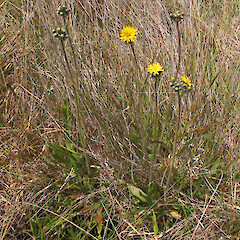Pilosella caespitosa
Common name
field hawkweed, meadow hawkweed
Synonyms
Hieracium caespitosum
Family
Asteraceae
Flora category
Vascular – Exotic
Structural class
Herbs - Dicotyledonous composites
NVS code
The National Vegetation Survey (NVS) Databank is a physical archive and electronic databank containing records of over 94,000 vegetation survey plots - including data from over 19,000 permanent plots. NVS maintains a standard set of species code abbreviations that correspond to standard scientific plant names from the Ngä Tipu o Aotearoa - New Zealand Plants database.
PILCAE
Conservation status
Not applicable
Habitat
Terrestrial. Grassland, scrub, tracksides, riverbanks, forest margins, roadsides, pasture.
Wetland plant indicator status rating
Information derived from the revised national wetland plant list prepared to assist councils in delineating and monitoring wetlands (Clarkson et al., 2021 Manaaki Whenua – Landcare Research Contract Report LC3975 for Hawke’s Bay Regional Council). The national plant list categorises plants by the extent to which they are found in wetlands and not ‘drylands’. The indicator status ratings are OBL (obligate wetland), FACW (facultative wetland), FAC (facultative), FACU (facultative upland), and UPL (obligate upland). If you have suggestions for the Wetland Indicator Status Rating, please contact: [Enable JavaScript to view protected content]
UPL: Obligate Upland
Rarely is a hydrophyte, almost always in uplands (non-wetlands).
Detailed description
Perennial herb 20-50 cm tall with basal rosette and stolons. Rosette leaves olive green to red, leaf underside with fine 1-3 mm scattered hairs on surface, mid-rib and edges. Yellow flowers in clusters of 5 - 20 heads per stem.
Similar taxa
The presence of stolons, multiple yellow flowers per stem, and fine hairs on the underside of the leaves distinguishes this species from all other Hieracium and Pilosella in NZ.
Flowering
November, December, January (March)
Flower colours
Yellow
Fruiting
December - February - (March)
Life cycle
Perennial. Reproduces from seed. Stolons can resprout after damage. Seeds produced October - May Seed dispersed by wind, clothing and animal pelts, rhizomes and stolons by water movement.
Year naturalised
1940
Origin
Europe
Reason for introduction
Accidental
Tolerances
Less tolerant of grazing than P. officinarum. Tolerant of low rainfall and poor soils.
Etymology
pilosella: Softly hairy
caespitosa: From the Latin caespes ‘tuft’ or ‘sod of turf’, meaning growing in tufts or patches
National Pest Plant Accord species
This plant is listed in the 2020 National Pest Plant Accord. The National Pest Plant Accord (NPPA) is an agreement to prevent the sale and/or distribution of specified pest plants where either formal or casual horticultural trade is the most significant way of spreading the plant in New Zealand. For up to date information and an electronic copy of the 2020 Pest Plant Accord manual (including plant information and images) visit the MPI website.
References and further reading
Johnson, A. T. and Smith, H. A (1986). Plant Names Simplified: Their pronunciation, derivation and meaning. Landsman Bookshop Ltd: Buckenhill, UK.


